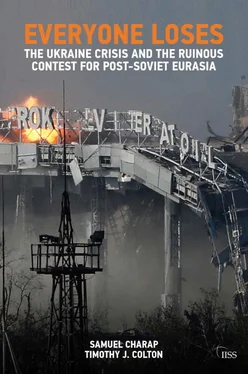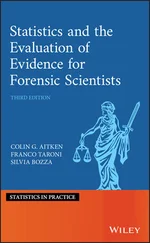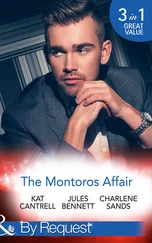However, the agreement collapsed immediately, largely due to domestic factors, and became another settlement-that-wasn’t. Within hours of the signing, Yanukovych’s authority buckled, as police deserted their posts throughout the capital. Protesters freely entered government buildings that riot police had secured hours earlier. Yanukovych fled Kyiv the next day and parliament voted 328–0 to remove him from office – an extra-constitutional act since there had been no statutory impeachment process – and to call new elections. Several days later, he surfaced in Russia.
The Maidan Revolution upended the balance of power among the macroregions of Ukraine. Of Yanukovych’s ministers, 75% hailed from the southern and eastern oblast s (provinces); in the new government, 60% came from the four westernmost oblasts (where only 12% of Ukraine’s population resides) and only two ministers were from the south and east. [28] Keith Darden, ‘How to Save Ukraine: Why Russia is Not the Real Problem’, Foreign Affairs , 14 April 2014, https://www.foreignaffairs.com/articles/russian-federation/2014-04-14/how-save-ukraine .
The speaker of the Verkhovna Rada (the parliament), a prominent Yanukovych ally, quit, and Oleksandr Turchynov, an MP known for his hard-line nationalist positions (and an associate of Tymoshenko, who was released from prison on 21 February), was selected to replace him. As speaker, he by law became acting head of state until a new president was elected. Within days, the Rada confirmed a government headed by Yatsenyuk, a Western-oriented politician; the other ministerial portfolios were divvied up among his party, Tyahnybok’s far-right Svoboda party and representatives of the Maidan protesters. The first steps of the post-revolutionary Rada merely reinforced the impression that southern and eastern Ukraine (with their sizeable Russian-speaking minorities), and not just Yanukovych, had been pushed out of power. Two days after Yanukovych’s fall, the Rada unwisely voted to repeal a 2012 law that allowed oblasts under certain conditions to use Russian or any other of Ukraine’s minority languages for official business, in addition to Ukrainian. Although Turchynov did not sign the repeal in the end, its passage alienated a substantial portion of the population.
Western leaders neither voiced concerns about these developments nor sought a new accord to replace the 21 February agreement, some provisions of which had now been overtaken by events. The day after the change in power, the US declared its ‘strong support’ for the new authorities. [29] ‘Secretary Kerry Speaks With Russian Foreign Minister Lavrov About the Situation in Ukraine’, 23 February 2014, https://blogs.state.gov/stories/2014/02/23/secretary-kerry-speaks-russian-foreign-minister-lavrov-about-situation-ukraine .
The EU foreign-policy chief, Catherine Ashton, travelled to Kyiv and stated that ‘the situation has moved on’ and therefore the 21 February pact could be disregarded. [30] ‘Remarks by EU High Representative Catherine Ashton at the End of Her Visit to Ukraine’, 25 February 2014, http://www.eeas.europa.eu/statements/docs/2014/140225_01_en.pdf .
Behind the scenes, some Western officials were celebrating the change in government in Kyiv, and saw no need to deal Moscow in, as they had on 21 February when Yanukovych was still in power. The then-US ambassador to Russia, Michael McFaul, later said he received numerous ‘high-five emails’ from colleagues in the days after the revolution. [31] Comments by McFaul during a talk at the German Marshall Fund of the United States in Washington DC on 9 June 2016.
The cause for jubilation in Western capitals was their seeming come-from-behind victory in the contest with Russia over Ukraine. The new government was bent on reversing Yanukovych’s relatively Russia-friendly foreign policy and resurrecting the EU AA. The elements of the 21 February pact that remained relevant, particularly the formation of a national unity government, the clearing out of protesters from occupied buildings and the confiscation of unregistered firearms, fell by the wayside. Moreover, no high-level outreach with Russia was attempted in the critical days following Yanukovych’s fall; Obama did not call Putin again until 1 March. After the interlude of cooperation on 21 February, the zero-sum dynamic was once again ascendant.
Unlike in the West, there were no high fives in the corridors of power in Moscow. Russian leaders insisted on the implementation of the 21 February agreement and cast aspersions on the new government as illegitimate and put in place by an unconstitutional coup d’état . [32] Lukas I. Alpert, ‘Russia’s Medvedev Calls Ukraine a Possible Threat’, Wall Street Journal , 24 February 2014, http://www.wsj.com/articles/SB10001424052702304834704579402922004993600 ; ‘Vystuplenie i otvety na voprosy SMI’, 25 February 2014, http://www.mid.ru/ru/press_service/minister_speeches/-/asset_publisher/7OvQR5KJWVmR/content/id/73790?p_p_id=101_INSTANCE_7OvQR5KJWVmR&_101_INSTANCE_7OvQR5KJWVmR_languageId=ru_RU .
The Russian ambassador to Ukraine was withdrawn. Putin and his advisers seem to have concluded that the collapse of the 21 February agreement resulted in part from a Western plot to install a loyal government in Kyiv that would move Ukraine toward the EU and even NATO. While no Western conspiracy in this simplistic form existed, the truth was not much better for Russia: individuals from the customary hotbeds of Ukrainian ethno-nationalism dominated the new administration; one in three ministers belonged to the far-right (and virulently anti-Russia) Svoboda party, and these authorities had come to power thanks in part to armed nationalist groups that still controlled government buildings in central Kyiv.
A spring snaps back
Within days, Russia struck back with a vengeance, as Putin set out to pry victory from the jaws of defeat by challenging the political order that had emerged after the Maidan Revolution. He had by this time run through all the standard plays in Russia’s foreign-policy playbook with Ukraine: economic coercion (the trade war in July–September), lavish economic assistance (US$15bn in assistance for Yanukovych in December) and diplomacy with the West (the 21 February agreement). None of these had worked. So Putin reached for the only tool he had yet to deploy. To force the new Ukrainian authorities and the West to take Russia’s interests into account, he decided to use the Russian military, now battle-ready after intensive reform and modernisation.
On or around 25 February 2014, special forces, paratroopers, and other men and materiel arrived in Crimea to bolster the sizeable contingent stationed there as part of the Black Sea Fleet, while other Russian forces deployed near the long land border with Ukraine and began large-scale drills. Russian commandos, the insignias removed from their uniforms, fanned out across the Crimean peninsula and began taking over Ukrainian military facilities and government buildings, including the Crimean parliament in the provincial capital of Simferopol, and setting up roadblocks. [33] For a full timeline of events leading up to and following the annexation of Crimea, see Colby Howard and Ruslan Pukhov (eds), Brothers Armed: Military Aspects of the Crisis in Ukraine (Minneapolis, MN: East View Press, 2015), pp. 209–13.
On 1 March, Putin obtained unanimous approval from the upper house of Russia’s parliament to deploy the armed forces on the territory of Ukraine ‘until the normalisation of the socio-political situation’ there.
If Putin had expected the invasion of Crimea and build-up along the border to force a return to something like the 21 February agreement, he was disappointed. Although the government in Kyiv was terrified, it refused a compromise on Russia’s terms. When the speaker of the Russian lower house, Sergei Naryshkin, called Turchynov to convey an ultimatum from Putin, the acting Ukrainian president responded by calling Naryshkin a war criminal, rather than agreeing to concessions. [34] ‘Stenohrama zasidannya Rady natsional’noyi bezpeky i oborony Ukrayiny vid 28 lyutoho 2014 roku’, 28 February 2014, http://komnbo.rada.gov.ua/komnbo/control/uk/publish/article?art_id=53495&cat_id=44731 .
While holding out for the prospect of an ‘off-ramp’ (i.e., de-escalation) if Moscow pulled back its forces, Western governments focused on condemning Russian violations of Ukrainian borders and threatening consequences, eschewing high-level diplomacy with the Kremlin that might have defused the crisis.
Читать дальше











